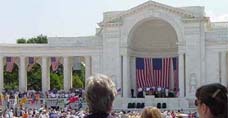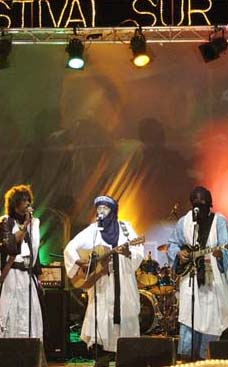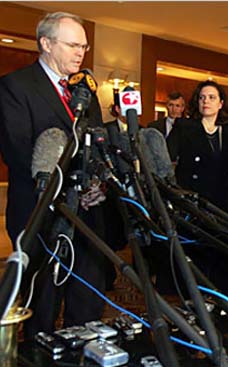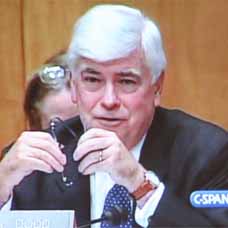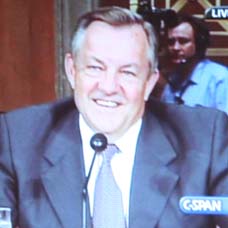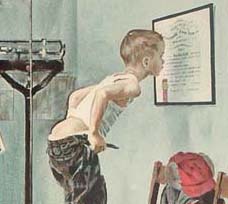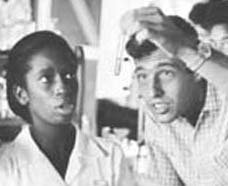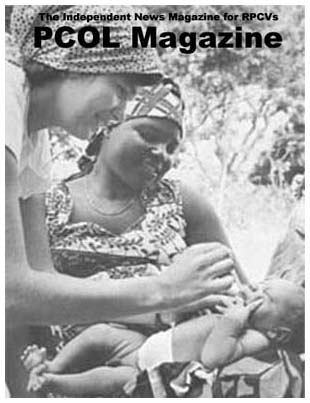
"The apparent unanimity of favorable response at home and abroad, when coupled with President Kennedy's strong belief in the National Peace Corps concept and his formal proposal for such a Corps in creating the Peace his State of the Union address, indicates that a National Peace Corps will be established. The question then is what are to be its scope and timing."
A Towering Task: Warren Wiggins' Architecture for the Peace Corps
A TOWERING TASK
I. INTRODUCTION: THE PRESENT TREND OF THINKING AND PROPOSALS
President Kennedy's desire to establish a National Peace Corps to assist peoples of underdeveloped countries obviously has struck an extremely responsive chord in America. The press, college students, private foundations, international volunteer and relief services and the trade unions have all reacted favorably, indeed enthusiastically, to the proposal. Public meetings and conferences to discuss the many aspects of a Peace Corps have been held on a variety of proposals, have been well attended, and indicate widespread public support for the proposal.
In June 1960 Senator [Hubert] Humphrey introduced a bill for the establishment of a "Peace Corps." Representative [Henry] Reuss of Wisconsin and the late Senator [Richard Lewis] Neuberger also introduced a bill, which was subsequently passed as an amendment to the Mutual Security Act, which calls for a study concerning the establishment of a Peace Corps. Professor Maurice Albertson of the Colorado State University Research Foundation, the ICA [International Cooperation Administration, the precursor to USAID] contractor for this study, is to complete the study by March 1 [1961].
At President Kennedy's suggestion, Max Millikan of the Center for International Studies at MIT recently submitted a report to President Kennedy recommending the establishment of a Peace Corps.
The apparent unanimity of favorable response at home and abroad, when coupled with President Kennedy's strong belief in the National Peace Corps concept and his formal proposal for such a Corps in creating the Peace his State of the Union address, indicates that a National Peace Corps will be established. The question then is what are to be its scope and timing. (It is indeed surprising that all public response has been positive. Those who may have doubts have only advocated caution in proceeding, not rejection of the proposal on its merits.)
While it seems to be true that some of those without experience in the management of overseas activities appear to minimize certain aspects of the difficulty of rapidly and effectively implementing this proposal, many with overseas experience tend to be overly cautious in their approach to it.
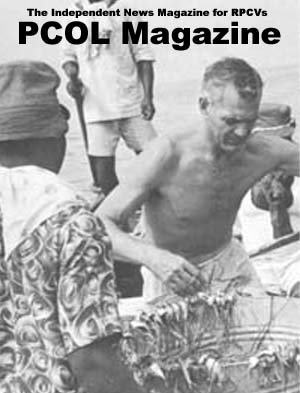
Most of the academic and other institutional approaches to the opportunity of the National Peace Corps suggest tentative pilot projects, involving small numbers of people and consequently a limited political, economic and psychological impact. This cautious approach is proposed by many because of the clear possibility of a fiasco. The organization and administration of a large number of Americans working on a variety of programs and projects in many countries with varying cultures and needs undeniably is an extremely complex and difficult undertaking. It is the prevailing view that if a great many Americans are scattered abroad and if significant numbers of them fail either in their own eyes or in the eyes of the recipient peoples, or if large numbers of the Americans have severe health, emotional or other problems, the resulting criticism will extend far beyond the project per se.
Thus, as far as can be ascertained, most of the individuals and groups who are in a position to advise President Kennedy counsel caution and a slow beginning. However, some elements of the trade unions are suggesting that President Kennedy think in terms of large numbers.
Generally speaking, those who are experienced are the most cautious. Many voluntary organizations with youths now abroad suggest that in the next year or so, if governmental financing were available, they could double the number of youths in their overseas programs. This would mean adding about 500 more youths to existing projects. Many International Cooperation Administration employees suggest expanding existing projects by adding youths as an extra personnel complement, thus making the "expert" more effective and going projects more efficient. Suggestions from the Department of State on the Peace Corps are indeed rare (presumably political problems abroad that might arise from such a Corps overshadow any latent ideas). }
Professor Albertson, after his initial and preliminary survey and consultation with interested individuals and groups, informally suggested (about January 10,1961) that perhaps something like 1,000 or 2,000 additional people might be sent abroad during 1961 under all facets of this program, including an expansion of the activity through the voluntary groups. Congressman Reuss recently suggested beginning at a 2,000-man level with a possible potential growth of the Corps to 10,000.
Thus, one course of action is becoming clear and apparently has the support of most people expressing an opinion: Proceed cautiously, start with small pilot projects, don't make mistakes, limit the program to 1,000 or 2,000 for a beginning (some say a few hundred), don't let this experiment get out of hand - in other words, find out the appropriate dimensions of the program by cautious exploration.
II. UNITED STATES MOTIVATIONS FOR A NATIONAL PEACE CORPS
Before attempting to assess present thinking about the Peace Corps, it appears essential to attempt to list the fundamental motivations for this activity. The following is neither all-inclusive nor mutually exclusive, but probably covers the main types of justification for the Peace Corps:
1. PROGRAM ACCOMPLISHMENT ABROAD.

Many Americans feel that there is a necessity to add another "tool" or "resource" to those presently available for accomplishing needed changes abroad. Not only do we need to bring another kind of asset to bear on our foreign problems, there is an urgency in these problems that demands we move more quickly. The National Peace Corps is a program that will allow the United States to move faster in many situations. This progress often requires the availability of large numbers of personnel, which would be provided under this program. The National Peace Corps would provide another way to expand education, to build a road, to promote 4-H Clubs, or to eradicate malaria. As such it holds forth the promise of potential accomplishment abroad of great importance to America.
2. TRAINING AND RECRUITING GROUND FOR OTHER ACTIVITIES
A second valuable contribution of the Peace Corps would be as a training and recruiting ground for future members of USIS, ICA, DLF, the Department of State, the foundations, business firms, etc.
3. PSYCHOLOGICAL IMPACT ABROAD OF AMERICAN YOUTH "PITCHING IN" TO WORK ABROAD.
Many National Peace Corps supporters claim that the greatest of benefits will occur as the people of other countries observe our youth helping other people to dig ditches, teach schools, and build feeder roads. Aside from completing a project, the greatest impact is said to be that America will be better understood, better liked, etc.
4. IMPACT ON AMERICAN SOCIETY AND AMERICAN ATTITUDES.

Less discussed but perhaps of great significance is the possibility that as Americans serve abroad over a period of time they become more oriented to the world scene and are better prepared to participate in world affairs. Many draw a parallel to the impact of American attitudes of having 14 million Americans under arms in World War II, a considerable portion of whom served abroad.
5. AMERICAN YOUTH WANTS TO SERVE ABROAD.
The simple fact that youth wants to serve abroad is perhaps the most important ingredient in describing the present national motivation. The magnitude of response by young Americans to the proposition of the National Peace Corps has yet to be fully ascertained, but certainly the preliminary indications are that the response, especially in the universities and colleges, is large and growing. This desire represents a composite of many emotions, feelings and attitudes. Some of this motivation comes from a desire for creative "adventure" in foreign lands, some from a high sense of altruism and desire to serve in a noble cause, assisting other peoples to obtain a better life, some comes from the possible relation of the Peace Corps to draft deferment, and some no doubt from a sense of boredom and frustration with present environment. In any case, from the United States Government point of view, this strong desire to "serve abroad" must be seriously considered.
6. "POLITICAL" MOTIVATION.
From a combination of the above considerations, it is clear that this proposed program has political support and is politically important. This "derived" motivation is listed here because it is in the "political" forum that the other motivations will produce the concrete results under consideration here. Religious, philanthropic and foundation-type institutions have already initiated their "youth corps" programs with their own criteria in mind. What is now under consideration is the National Peace Corps that would be sponsored by the United States Government and developed by political bodies.
III. A FEW MAJOR DIFFICULTIES WITH PRELIMINARY PROPOSALS
The following considerations of the preliminary proposals are offered with the realization that it is not yet fully appropriate to examine the proposals made to date since, in most cases, they represent but "approaches" to the subject, not full-blown, well-developed courses of action. Nonetheless, there is an almost universal tendency toward the conclusions indicated in Part I above, and such conclusions may well be imbedded in decisions by the administration and in legislation considered by the Congress in the next few weeks or months. Thus it is believed necessary to attempt to assess the developments to date even though only a few have been crystallized in concrete proposals of action.
The first major difficulty with most of the thinking that has been expressed to date (as summarized in Part I above) is that if the overall program is launched at the 1,000 to 2,000-youth level, it will be more likely to fail in the absolute sense than at a level, say, five or ten times greater. Generally speaking, such small numbers won't be significant enough in the recipient countries to get the governmental and institutional attention it needs. Exceptions can, of course, be found, but it is believed that they will be rare. Sending 100 students to a Latin American country won't be important enough to get presidential support from that country. Active support from a Minister of Agriculture, Health or Education would be surprising as a general rule. And if the county needed to give legislative or financial support, it might not be forthcoming. However, 1,000 or 5,000 Americans, working on something important in a single country, would merit considerably more political, administrative and financial support. One hundred youths engaged in agricultural work of some sort in Brazil might pass by unnoticed, except for the problems involved, but 5,000 American youths helping to build Brasilia might warrant the full attention and support of the President of Brazil himself.
Likewise, if a program of 100 youths were to be launched in a Far Eastern country (with, say, 30 arriving the first year), it might be negotiated by an Ambassador who would be thinking: 1) What can 100 youths do? 2) What will Washington think of next? 3) We have too many Americans here in this country, anyway; 4) What a terrible chance we are taking with all these kids; 5) I wonder if the Foreign Minister will pay any attention to it - and if he doesn't, maybe we won't have a Peace Corps program here after all; and 6) If he does, maybe we can keep the number down to 30 and cancel out the additional youths contemplated for the second year.
However, if the program is launched at a considerably higher level and selected countries can receive a number large enough to do an important national job, it will merit attention abroad and won't be just another annoyance to the Foreign Office - it will have the potential of developing into a major asset of mutual importance. To some extent, there may be a parallel set of circumstances in the United States. A program of 1,000 or so youths may not merit sufficient administrative and legislative attention to overcome the very real difficulties in this complex program. A small program may become mired down in the application of routine rules, regulations and priorities.
Let us suppose the Marshall Plan had been started a year or two earlier than 1948 when the "need" for massive effort was not as clear and that the proposal would have been for a two-year, $2 billion program rather than a four-year, $17 billion program. Paul Hoffman probably wouldn't have been its Director - the influx, of able talent to assist him would not have occurred in the magnitude it did - the Congress might not have created a separate agency to handle the job, but instead might have asked the Department of State to administer the resources with an advisory committee - Europe would never have formed the OEEC - the Russian attitude might have been quite different. Two years later (1948), when the real, larger need became apparent, the program might have been in disrepute and the Congress might then have turned it down. Thus, history might have recorded the European Recovery Program as a failure because it wasn't started on a scale sufficiently large to enable the United States and the European countries to "handle it right."
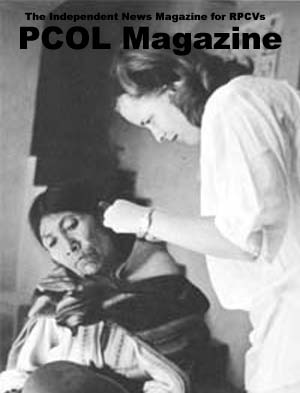
In other words, it is here postulated that a "small," "cautious" National Peace Corps may be worse that no Peace Corps at all. It may not receive the attention and talent it will require even for preventing trouble. A. slow, cautious start may maximize the chance of failure. A small, cautious National Peace Corps may be a diversionary path of inconsequential accomplishment (see below) and major administrative and diplomatic trouble.
The second major difficulty is that the small contingents concept is limited in scope to Peace Corps such a degree that it probably makes little difference whether or not we have a Peace Corps.
There are at least 60 countries eligible to receive the Corps. Let us suppose it grows from a starting-year size of 500 or 1,000 youths to 5,000 by the end of President Kennedy's first term. Let us suppose 50 countries become involved, with an average of 100 youths each at the end of the first four years.
The contribution of a group of youths this size to the affairs of each country concerned will be negligible. Generally speaking, there is not sufficient expertise in the potential volunteers for the National Peace Corps to be advisors or organizers. They must be limited to performing those functions that have an "ordinary" rather than a "catalytic" effect. These youths generally will not have professional or technical experience to make a contribution on a national scale if their numbers are small. One hundred "workers" or teachers in countries with many millions of people cannot contribute enough to make a real "difference" in the history of the country.
The third major difficulty is that a program starting at the 1,000-2,000 youth level and growing to 5,000 will be an inadequate response to the following motivations: 1) American youth wants to serve abroad; 2) psychological impact abroad; 3) impact on American society; 4) political aspects. From these points of view, even at a 5,000- man level only one youth in every 600 (?) who becomes 21 years of age would be able to serve in the Peace Corps -or from another, more restricted point of view, if all the youths were drawn from our colleges and universities, on the basis of present enrollments only one youth in every 100 graduates would be able to serve. (Obviously, with the potential doubling of the college and university population in the next 10 years the figure would be about one in 200.) With regard to psychological impact abroad, a total of 5,000 youths and 50 countries (an average of 100 youths per country) is believed to be an insufficient number to produce a psychological impact of great enough importance to be a major justification for the National Peace Corps.
From a political viewpoint, given the response by American youth that this paper assumes, a National Peace Corps that allows an average of only two or three youths to enter each year from each college and university (not to mention the myriad number of other eligible youth) may well produce a negative political impact. An anticipated bold "new frontier" may fall into disrespect rather rapidly.
These three major difficulties are believed to be of such magnitude that they cast serious doubt on the wisdom of proceeding to implement the National Peace Corps on the limited scale now generally envisioned.
It is possible that with extremely good fortune the program would be "satisfactory"; that is, it would avoid major trouble, but its relative cost would be high and its true value to the underdeveloped areas insignificant.
IV. PURPOSE OF THIS PAPER
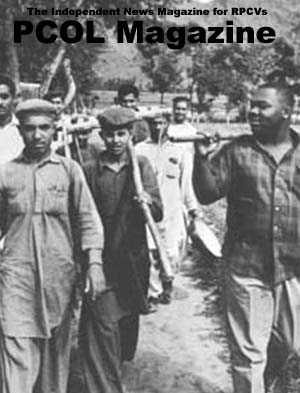
The purpose of this paper is to advocate consideration of a "quantum jump" in the thinking and programming concerning the National Peace Corps. Its postulate is that America ought to consider initiating the program with several thousand Americans participating in the first 12 to 18 months - say, 5,000 to 10,000. The ultimate level of manpower to be utilized in this program will of course depend upon its initial success and difficulties. However, the potential of this program is great and it may prove to be the case that it should be at the 30,000, the 50,000 or possibly even at the 100,000 level. Even this latter higher level Corps over the past 35 would mean that only one out of every 30 years. (?) youths would serve in the Peace Corps.
Since it is somewhat difficult to illustrate abstractly the general thesis of the nature and value of a National Peace Corps involving a great many thousands of Americans, this paper proposes the following illustrative 5,000-youth, one country program for examination. Following the examination of this program, some generalities will be suggested about the possibility of, and the advantages and disadvantages of, a National Peace Corps of large dimension.
V. A 5,000-MAN ONE-COUNTRY PROGRAM
[omitted because of space limitations.]
VI. CONCLUSION - RELEVANCE OF PHILIPPINE PEACE CORPS PROGRAM TO WORLDWIDE NATIONAL PEACE CORPS
It is believed that the National Peace Corps English Teaching Program in the Philippines herein proposed supports the postulate of this paper that America ought to consider a Peace Corps of large magnitude. If, for example, up to a million American youths were to serve abroad in the next decade, the contribution to the free world - and to America - might be enormously important. This suggestion is, of course, highly assertive and this paper cannot attempt to demonstrate its validity.
However, following the same kind of argument for the teaching of the English language in the Philippines, it certainly would be fruitful to explore a 5,000 to 10,000-man-per-year project in English language instruction in Nigeria. In India, if the program were acceptable and worthwhile from the Indian point of view, it is not impossible to imagine a 50,000 Peace Corps teacher force in India. And - at this level - the Peace Corps might become a tremendous asset in Indian planning. Pakistan likewise offers a vast potential. In Mexico there is certainly the possibility of using a few thousand Peace Corps English teachers. Thus, in one field - English language teaching - it is here postulated that very large numbers of Peace Corps teachers could be most usefully employed.
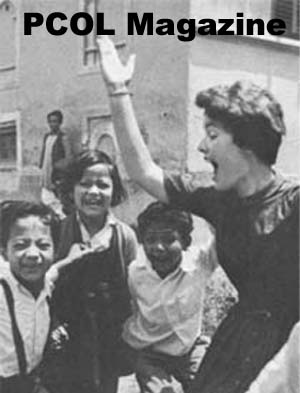
Such a national effort on the part of the United States can not be undertaken easily or without a great deal of thought and preparation. This paper does not advocate that there is a clear conclusion that we ought to have a large National Peace Corps. What it does advocate is that a National Peace Corps starting on a small scale and growing, say, to the 5,000 level on a worldwide basis, is a marginal undertaking and may, on balance, cause more trouble than it is worth. Because this paper postulates that there is a large and fundamental motivation behind the Peace Corps idea of national and international importance, it advocates making a real assessment of the relative value and cost of starting large and accelerating to the extent that the program's contribution is commensurate with its cost.
VII. RECOMMENDED NEXT STEPS
Based upon the above discussion of the National Peace Corps, other reports and analyses, speeches and articles which have appeared to date, it is believed that certain preliminary decisions with respect to the Peace Corps and an interim administrative organization need to be taken. This section proposes an approach to such interim action.
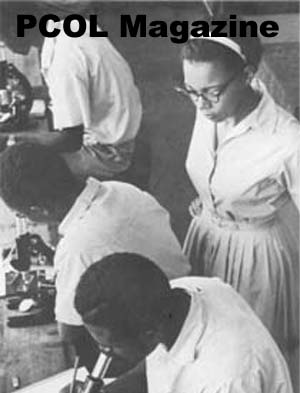
The Executive Branch should decide that the Peace Corps will be launched in calendar year 1961 and at a level sufficiently large to: 1) Assure maximum chance of success; 2) demonstrate that major activities can be undertaken in particular countries; and 3) test the wisdom of a variety of types of approaches and activities. Thus, it is believed that in February President Kennedy should decide that, even in advance of legislation and formal administrative structure, the Peace Corps will be launched with a major Presidential statement or speech, that a call for volunteers will be thus issued, that preparatory work for a series of specific pilot projects will begin, that screening of applicants will be under way, that to the extent necessary appropriate contracts will be negotiated and that selected foreign governments will be contacted.
To accomplish this, a variety of alternative administrative structures are feasible. However, none appears to be as efficient, desirable or as quick as utilizing the existing overseas agency which handles the bulk of U.S. overseas activities and personnel -the International Cooperation Administration. is recommended that a new Deputy Director be appointed immediately in ICA [Wiggins was then Deputy Director at ICA] to serve as the Peace Corps Administrator. This Deputy Director, his staff and activities would be funded by a Presidential Determination, utilizing Mutual Security funds through the exemption route (Section/of the Mutual Security Act). He would be given an immediate authorization for an administrative and program staff in Washington, D.C. of up to 150 people to initiate the activity. This group would be recruited on a priority basis over the months ahead. This group would be a somewhat separate organizational unit within the ICA and it would draw on the services and skills of the rest of the agency but would have full organizational responsibility for the administration of the program (as indicated, this would of course be an interim arrangement pending an overall reorganization of foreign economic activities).
It is assumed that such a Deputy Director would be a man of national stature in whom President Kennedy, Secretary Rusk, Under Secretary Ball and Mr. Labouisse would have full confidence.

The Administrator of the National Peace Corps would be charged with the development of an immediate program which would look toward the utilization of, say, 5,000 to 10,000 youths in the next 12 to 18 months. Certain major projects should be undertaken, such as the Philippines proposal contained in this paper, which would utilize 1,000 youths the first year. Probably a parallel English teaching program for Nigeria ought to be instituted immediately, involving another thousand teachers. The National Peace Corps could also be effectively used in health programs such as malaria eradication and smallpox vaccination, particularly in Africa. The existing voluntary agency programs for youths abroad should be expanded as rapidly as possible to absorb up to an additional thousand youths in the next 18 months. Maximum utilization should be made of National Peace Corps personnel in the regular "Point IV" activities of ICA abroad in some 60 countries, which could probably make use of 1,000 youths in the next 18 months. Likewise, Peace Corps personnel could be attached to the 40 university contracts abroad, adding, for example, another 300 to 400 to the total.
These and the host of other activities that have been suggested should be carefully screened and selected projects initiated. The actual final number to be enrolled in the Peace Corps in the first 12 to 18 months should of course depend upon the volume of good programs that can be developed and successfully administered.
@
